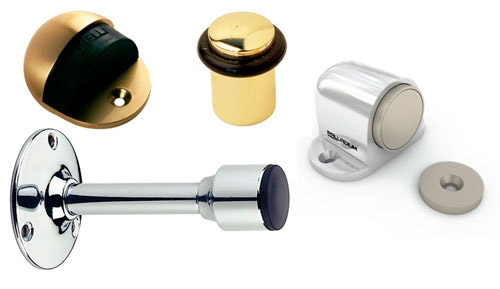Stoppers and limiters for interior doors
Stops or door stops are designed to protect the door and the walls during the opening process from all sorts of scratches and damage. Not allowing the door to swing open excessively, they form the maximum amplitude of its operation. Their use eliminates the rapid wear of the canvas or walls located too close, and the owners do not have to constantly repaint them or replace the wallpaper. The built-in magnet secures the door in the desired position, providing convenience. Limiters reduce the speed of the door and prevent it from moving where it is not required.

There are two types of stops – wall or floor, in some cases both of these options are used at once. The floor stop assumes the need to take into account the distance between the floor and the canvas, the limiter must match. Place it ideally on the width of the door handle on the side of the wall, at the very end of the moving part, or no further than the middle of the canvas. Do not put it closer to the loops, this approach can damage them. In passageways, it is placed closer to the wall.
Good stops can be created from zinc and aluminum alloys, steel and brass, copper alloys. Each solution has its own pros and cons: for example, brass successfully resists corrosion, has a beautiful appearance, and is polished. It is not cold to the touch and reliable metal, ensuring long-term operation of the elements. But brass darkens, and to avoid this, it can be varnished.
Steel is another common option, it is a functional and durable approach. It provides a beautiful noble appearance in full, it will last for several decades, the only drawback here is the complexity of processing the material.

The forms of the stop can also vary from simply curved to equipped with decorative additions. A pin driven into the floor can also serve as a stop, which prevents the door from hitting the wall when it is opened. They can also be designed in different ways. Choose an option based on the installation location, other accessories and interior.
Pub date: 2021.06.01